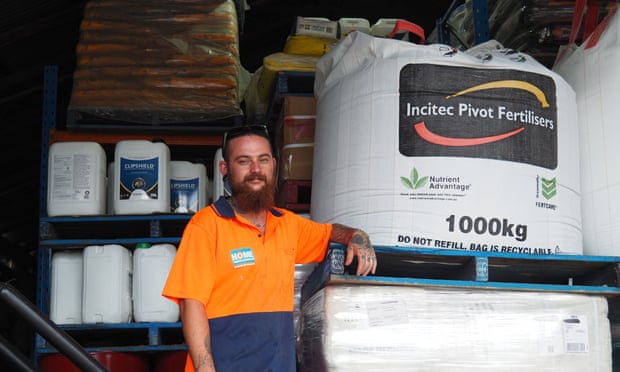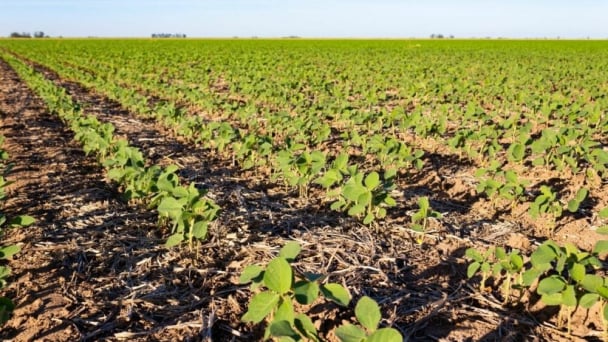May 17, 2025 | 19:34 GMT +7
May 17, 2025 | 19:34 GMT +7
Hotline: 0913.378.918
May 17, 2025 | 19:34 GMT +7
Hotline: 0913.378.918

Bryce Budworth works at agricultural supplies outlet GK & LH Rohr in Gilgandra, where the price of fertiliser has shocked customers. Photo: Natasha May/The Guardian
Surging energy costs and export restrictions from usual overseas suppliers are leading to record high fertiliser prices in Australia, with analysts predicting farmers could be forced to ration its use, potentially disrupting global food supply.
Modelling from Thomas Elder Markets shows the price of fertiliser in Australia is at a record $1,320 per tonne for purchase, freight and discharge.
Agricultural market analyst Andrew Whitelaw says fertiliser prices had been rising since the start of the year but have skyrocketed since August.
He said as a result, “we’ll see more rationing, as farmers will use less fertiliser because it’s too expensive” which could disrupt the global food supply chains.
“Fertiliser is one of the key components ensuring we’re able to feed the world.
“If farmers are using less fertiliser, there’s the potential for lower yields and if there’s lower yields there’s less food to go around.”
Organic wheat, for example, yields 30% less on average than the synthetically fertilised equivalent, according to Whitelaw.
The prices of the two main sources of energy used to produce fertiliser – natural gas and coal – have “gone through the roof”, according to Whitelaw and that has a corresponding effect on fertiliser price.
The high energy prices have hit some of Australia’s biggest international suppliers, who have consequently acted to safeguard supplies for their own domestic markets.
Australia has previously imported 60% of both monoammonium and diammonium phosphate fertilisers from China, but it has restricted exports of fertiliser, while Russia has imposed a quota.
Whitelaw said Australian farmers are buying fertiliser from Morocco but prices are being driven up by a global shortage and the greater distance incurs higher freight costs.
Whitelaw says food prices are all increasing on a global level.
“For the average Australian, we’re still going to be able to afford what we want to eat. It’s more a concern if you’re a consumer in Afghanistan, Kenya or Somalia.”
Chief economist at the National Farmers Federation, Ash Salardini, says it’s a price concern but “freight supply chains are stretched and Australia is a particularly inefficient port system that adds costs and delay and disruption that the end user has to pay for.”
Grain farmer and chair of the NSW Farmers Grains Committee, Justin Everitt, says the cost of fertiliser for the coming season has become “unmanageable.”
“You can see there’s a lot of stress. Very rarely do you try to lock in fertiliser supplies this early, before you’ve even harvested the previous crop.”
Everitt said farmers are concerned prices will stay prohibitively high, making it difficult for them to remain profitable.
He said in addition to the fertiliser price increases, farmers were already feeling the high prices of fuel, on top of the labour shortages.
Chair of Birchip Cropping Group in Victoria, John Ferrier, said both supply and price of fertiliser have been big issues.
Ferrier said as soon as prices started to move three months ago, with urea and then phosphorus rising dramatically “we made the business decision at our farm to secure price and have on-farm supply of phosphorus for next year’s crop.”
The manager of an agricultural supplies shop in Gilgandra NSW, Patrick Riley said prices are “through the roof” and have left customers “shocked and unsure what they’re going to do”.
Industry representatives and politicians have recently held a green fertiliser industry roundtable to discuss the potential for domestic manufacturing of cheaper and greener fertiliser.
Fertiliser manufacturer Strike Energy is aiming to use hydrogen to produce a greener fertiliser by developing a plant at Geraldton, in Western Australia’s northern wheatbelt.
However, Whitelaw who presented at the roundtable discussion said new green fertiliser plants in South Auastralia and WA were a long way from producing fertiliser: “probably more like five years than the next year.”
In terms of short-term solutions, Ferrier said the industry could see a change in crop rotations in favour of crops that produce nitrogen such as pulses, to improve the health of soils.
Farmer Dianne Haggerty, who does not use artificial fertiliser, believes the high prices are a “reflection of the true cost of using artificial fertilisers”. That is, their impact on the environment such as nitrogen and phosphorus runoff affecting waterways and oceans, as well as the release of nitrous oxide.
Haggerty believes any lower yields resulting from avoiding artificial fertiliser would only be a short-term issue as farmers rebuild their soil capacity.
She said the advantages of turning away from artificial fertilisers mean over time “you have a more resilient farming system that isn’t requiring artificial inputs”.
She says as artificial fertilisers continue to escalate in price, alternatives will help farmers’ businesses financially and will become even more relevant as carbon accounting emissions exchange start affecting bottom lines.
As a pig farmer, Whitelaw said he supported manure usage but in addition to the problem of yield discount, “the reality is that there’s not enough organic fertiliser produced in Australia to meet the demands of the horticulture and cropping industry”.
(The Guardian)

(VAN) Fourth most important food crop in peril as Latin America and Caribbean suffer from slow-onset climate disaster.

(VAN) Shifting market dynamics and the noise around new legislation has propelled Trouw Nutrition’s research around early life nutrition in poultry. Today, it continues to be a key area of research.

(VAN) India is concerned about its food security and the livelihoods of its farmers if more US food imports are allowed.

(VAN) FAO's Director-General emphasises the need to work together to transform agrifood systems.

(VAN) Europe is facing its worst outbreak of foot-and-mouth since the start of the century.

(VAN) The central authorities, in early April, released a 10-year plan for rural vitalization.

(VAN) Viterra marked a significant milestone in its carbon measurement program in Argentina, called Ígaris, reaching 1 million soybean hectares measured.